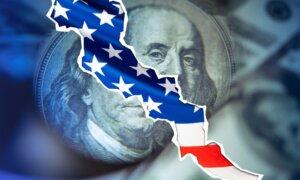U.S. economic growth for the fourth quarter was revised downward for the final three months of 2023, missing market expectations. Despite revisions in the second estimate of the gross domestic product figures, the national economy still showed robust growth.
The updates reflected a downward adjustment to private inventory investment and upward changes to consumer and state and local government spending.
Like the advanced estimate, the increase in real GDP in the last quarter was driven by exports, residential and non-residential fixed investment, consumer outlays, and federal, state, and local government spending.
Consumer spending contributed 2 percent to the final GDP reading and represented nearly two-thirds of growth. Government consumption expenditures and gross investment added 0.73 percent to the final tally and accounted for 23 percent of the real GDP boost.
On the inflation front, the personal consumption expenditure (PCE) price index, the Federal Reserve’s preferred inflation gauge, rose to a higher-than-expected 1.8 percent. Core PCE, which strips out the volatile energy and food sectors, ticked to 2.1 percent in the fourth quarter.
In addition, the GDP Price Index, a measurement of inflation in the prices of goods and services manufactured in the United States and exported to other countries, jumped 1.9 percent, unchanged from the first estimate and higher than economists’ expectations of 1.5 percent.
Elsewhere in the GDP report, personal income numbers experienced downward revisions. Current-dollar personal income advanced $219.5 billion in the fourth quarter, down $5.4 billion from the previous estimate.
“The increase primarily reflected increases in compensation, personal income receipts on assets, and proprietors’ income that were partly offset by a decrease in personal current transfer receipts,” the BEA stated in the report.
Real (inflation-adjusted) disposable personal income rose by 2.2 percent, representing a downward change of 0.3 percent.
‘Splashy Gorilla Number’
The latest GDP revisions are “immaterial” since they were muted and will unlikely play a factor in financial markets or monetary policymaking, according to Connor Lokar, an economist at ITR Economics.“We don’t particularly love GDP because it’s the big splashy gorilla number in various ways,” Mr. Lokar told The Epoch Times. “Typically, they’re going to revise it multiple times to finalize the numbers.”
Because of this, Mr. Lokar prefers to assess monthly metrics, such as retail sales and industrial production, as they can offer a better glimpse of the current economic climate.
In January, retail sales tumbled by 0.8 percent, and industrial output dropped by 0.1 percent.
Meanwhile, stocks were down in the early part of the Feb. 28 trading session, with the leading benchmark indexes down as much as 0.5 percent. Investors are waiting for the PCE inflation data for January.
U.S. Treasury yields were red across the board. The benchmark 10-year yield fell below 4.29 percent. The 2-year yield slumped to 4.67 percent, while the 30-year bond slid under 4.42 percent.
PCE and core PCE are projected to rise by 0.3 percent and 0.4 percent, respectively. On an annualized basis, they are forecast to slow to 2.4 percent and 2.8 percent, respectively.
As for the consumer price index (CPI), the Cleveland Fed Inflation Nowcasting model estimates an unchanged reading of 3.1 percent. The core CPI is seen slowing to 3.7 percent.
Reading GDP Tea Leaves
Looking ahead to the first quarter, early estimates suggest another robust GDP reading. The Federal Reserve Bank of Atlanta’s GDPNow Model points to 3.2 percent growth during the January-to-March period.For the year ahead, economists have updated their outlooks.
“The stronger February growth forecasts for 2024 result from upward revisions to key sectors of the economy, including personal consumption expenditures, nonresidential fixed investment, residential investment, and government consumption expenditures and gross investment,” Ellen Zentner, the NABE president and chief U.S. economist at Morgan Stanley, said in a statement.
The Conference Board economists abandoned their recession call, forecasting slower growth of less than 1 percent in the second and third quarters.
David Rosenberg, the president and founder of Rosenberg Research, said he anticipates growth will be flat this year.
Mr. Lokar said he believes that a majority of sectors could begin “to feel some turbulence” this year.
“I think some folks might have just jumped the gun a little bit on the 2023 recession calls,” he added. “I think folks are also jumping the gun now, prematurely declaring victory.”
Although the debate about whether the U.S. economy is hitting a soft landing rages on, another prominent economist disagrees with the narrative that the nation has averted a downturn.
Peter Schiff, the chief economist and global strategist at Euro Pacific Asset Management, said the United States might already be in a recession.
“I think there’s a pretty good chance that we’re actually hitting one right now,” Mr. Schiff told The Epoch Times. “And the government may acknowledge that maybe sometime after the election, they may go back and revise a lot of the economic data to reveal a recession.”
Mr. Schiff said that happened in 2007 and 2008. The Great Recession started in December 2007, but the government reported positive GDP numbers for a year.
“The government doesn’t necessarily tell you that you’re in a recession. Initially, it could take a long time, and I think this may be another case where the data is wrong,” he said.







